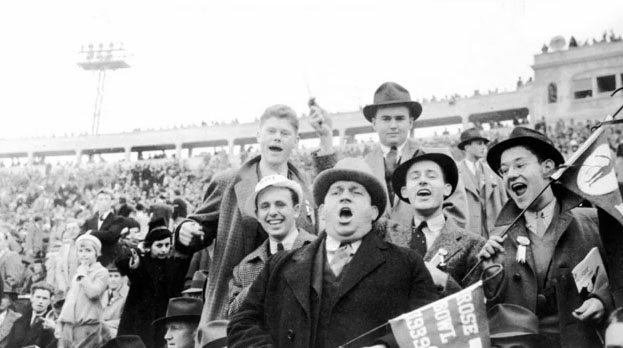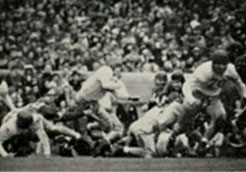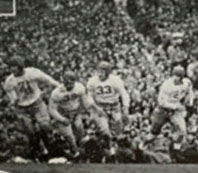|
Memorable
Football Games – V
January 2, 1939: Duke vs Southern California
Led by All-American co-captains C Dan Hill and TB Eric "The Red" Tipton, the 1938 Duke Blue Devils crafted one of the most remarkable seasons in college football history.
- Wallace Wade's eighth Duke squad since leaving Alabama for Durham won all nine games they played.
- They also shut out the opposition in every contest. That's right - they were undefeated, untied, and unscored on!
|
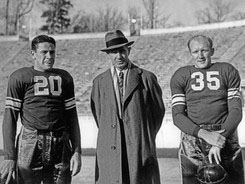
Eric Tipton, Wallace Wade, Dan Hill |
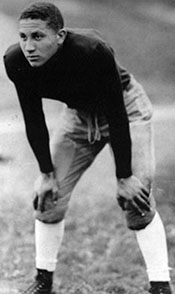
Wilmeth Sidat-Singh
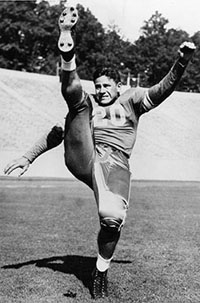
Eric Tipton
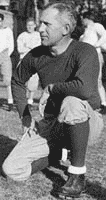
Howard Jones
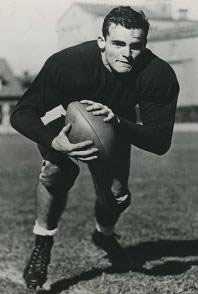
Grenville Lansdell
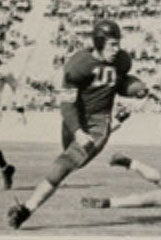
George McAfee
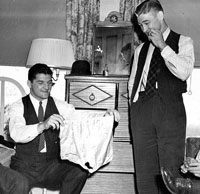
Duke Panties

Coach Wade and Duke team visit Hollywood
|
The team earned a nickname early in the season that lives on in history.
- After the 6-0 victory over Georgia Tech in the fourth game, Bill Cox, a reporter for The Virginian-Pilot, referred to the team as "The Seven Iron Dukes." The monicker stuck without the seven.
Duke's seventh game of the 1938 season at Syracuse provoked a huge controversy because Coach Wade decided to violate a sacred Southern tradition. Syracuse was led by a black quarterback, Wilmeth Sidat-Singh. For many years, there had been a "gentlemen's agreement" for games between Southern and Northern schools that any blacks on the Northern school roster would not compete. However, Wade wanted to beat the Orangemen at their best. Remembering his playing days at Brown as a teammate of RB Fritz Pollard, who would play in the NFL and become its first black head coach, Wallace did not insist that Wilmeth stay on the sidelines. Many Duke alums and supporters voiced their opposition to the decision, one even writing the university president demanding that Wade be fired if Duke played "against that n-----." The Blue Devils shut down Sidat-Singh in a 21-0 victory, and Wade weathered the storm.
- Despite whitewashing every opponent, Duke was only #3 in the Associated Press poll as it prepared to meet its final regular season foe, Pittsburgh, known for its high-scoring offense that had put 24 or more points on the board in six games.
- The game was held in Duke Stadium in snowy conditions on November 26 before a crowd of more than 45,000. There was still no score by the end of the third quarter. The game turned on two crucial plays. First, Tipton, considered the finest punter in the nation, booted the ball to the one. When Pitt attempted to kick out of danger, E Willard "Bolo" Perdue blocked it and recovered in the end zone. When "True-Toe" Tony Ruffa converted the extra point, Duke took a 7-0 lead that it preserved until the final horn. The crowd stormed the snow-covered field in celebration.
Watch video of the Duke-Pitt game
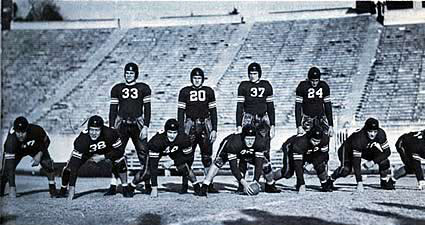
1938 Iron Dukes
- The Devils remained #3 in the final Associated Press poll behind two other 10-0 teams, #1 TCU and #2 Tennessee.
Duke accepted its first bowl invitation in school history.
- Despite intense lobbying by TCU, which may have hurt rather than helped their cause, the Rose Bowl committee chose the Blue Devils to face the kings of the Pacific Coast Conference, #7 Southern California, in the 24th Rose Bowl.
- Since 1935, the Tournament of Roses Association had a contract with the Pacific Coast Conference (PCC) that its champion would automatically earn a Rose Bowl berth and choose the opponent. Association leaders played a behind-the-scenes role in the process to ensure that an attractive Eastern opponent would be invited to fill the seats in the mammoth stadium.
Texas Christian fans bombarded Los Angeles newspapers with phone calls and telegrams asking for support. TCU backers also contacted the governor of California and members of the state legislature. One Texan sent turkeys as Thanksgiving presents to Los Angeles sportswriters. But the choice lay with the host team, USC. Sportswriter Braven Dyer later explained, Trojan authorities felt that they couldn't retain their self-respect as an educational institution if they succumbed to the pressure exerted by well-meaning friends of Texas Christian.
The Horned Frogs went to the Sugar Bowl, where they defeated #6 Carnegie Tech 15-7.
- The Associated Press reported on the reaction in North Carolina.
DURHAM, N.C. This tobacco-manufacturing city of 50,000 went wild when word spread that the Duke University football team had been selected to play Southern California in the Rose Bowl.
Students, led by the sixty-piece Duke band, marched from the university campus through the downtown streets amid whoops and yells.
Officials said the bid was accepted after a telegraphic poll of Southern Conference members. The conference has a rule forbidding post-season games. Coach Wade said enough votes had been received to "justify acceptance of the bid."
- Wade was no stranger to Pasadena. He went as a guard-tackle on the Brown team that played in the 1916 Rose Bowl against Washington State. He also took three of his Alabama squads to Pasadena. The Tide edged Washington 20-19 in 1925, tied Stanford 7-7 the following year, and bested Washington State 24-0 in 1930.
- Some West Coast writers criticized Duke's selection, insisting that the Blue Devils faced "weak" competition in the Southern Conference, and Southern football in general was still regarded as inferior (despite Alabama's 2-0-1 record in Pasadena under Wade).
Howard Jones's Trojans had survived a down-and-up-and-down-and-up season.
- USC lost its opener, 19-7, to Alabama at home, then won six in a row, including handing California its first defeat in 18 games, before stumbling in the mud at Washington 7-6.
- The Trojans improved their national rankings with back-to-back victories over UCLA 42-7 and #1 Notre Dame 13-0 before 97,146 in the Los Angeles Coliseum.
- Like Wade, Jones had yet to taste defeat in three trips across town to the Rose Bowl, having defeated Pitt 47-14 in 1929, Tulane 21-12 two years later, and Pitt again, 35-0, in '32.
Despite Duke's outstanding record and higher ranking, West Coast scribes considered the Trojans to be too big, fast, and deep for the invaders from the East.
- The Rose Bowl was billed as a showcase for two triple-threat tailbacks, Tipton and Grenville "Granny" Lansdell of the Trojans.
- Hurting the Duke cause were nagging injuries to Hill and speedy back George McAfee (who was destined for a Pro Football Hall of Fame career with the Chicago Bears).
The Blue Devils got an unexpected and unusual good luck charm for their trip to California.
- An anonymous fan mailed a pair of silk panties to "Eunice" Tipton and "Agnes" Hill via Ted Mann, Duke sports publicity director.
- Some Devils fans decided to take similar panties to the Rose Bowl and place them on USC's goal posts after the game to replace the pants Duke whipped off the Trojans.
- As Wade boarded the train, he was handed a good-luck letter from archrival North Carolina's student body.
Duke fans by the hundreds boarded trains for the trek clear across the continent to Pasadena.
- The team visited Hollywood and met stars they had admired on the big screen.
- The fans enjoyed the famous Tournament of Roses parade the morning of the game.
|
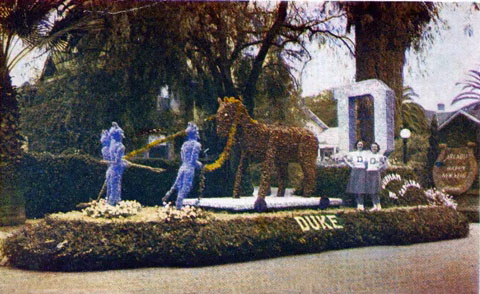 Duke
Duke's award-winning entry in the Rose Parade Continued below ...
January 2, 1939: Duke vs Southern California
Before the game begins, let's review the rules and practices of football in the late 1930s.
- The main difference from today's sport lay in the substitution rules.
Substitutes may enter the game any time the ball is dead. However, any player leaving the game in the first half may not return until the second half. And a player leaving the game in the second half is out for the rest of the contest.
- Since players had to play both ways, the defensive alignments generally mirrored the offensive formations. The center dropped back to become a linebacker while the other five offensive linemen formed the defensive line. The four backs joined the center in the secondary with the fullback generally playing linebacker alongside the center.
- The predominant offense was the single wing. A few teams had introduced the T formation, but it wouldn't be until after World War II that the T swept the nation.
- Except for pioneering teams like TCU and SMU, coaches generally built their offenses around running the ball.
- Duke coach Wallace Wade was a prime practitioner of "Southern football." Play conservatively and wait for the opponent to make a mistake. He preferred to punt the ball into enemy territory on third, second, or even first down than possess it deep in his own territory.
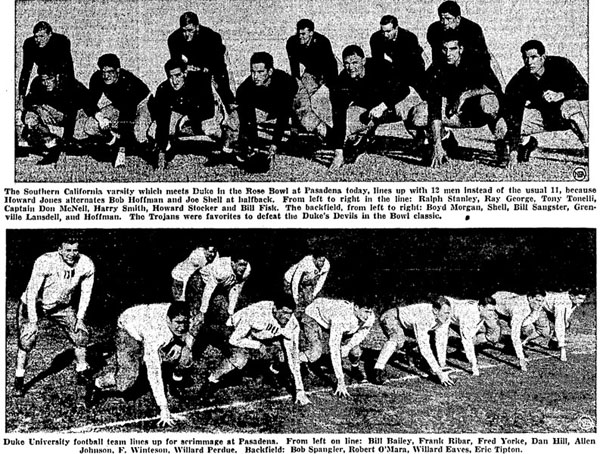
The Starting Lineups

A record Rose Bowl crowd of 89,452 endured several bouts of rain to watch a game that some writers immediately labeled the greatest of the series that began in 1916.
- That opinion is debatable since you could have slept off your New Year's hangover until the middle of the third quarter and missed nothing important. Almost all the excitement was packed into the last five minutes of play.
- Among those not in attendance was future USC President Norman Topping (1958-70), a graduate of the USC medical school who was quarantined in a hospital with Rocky Mountain Spotted Fever and a 105-degree temperature. He recalled later:
I was dying. They had given up on me. No visitors, not even my wife.
- When he asked for a radio to listen to Bill Stern's broadcast on NBC, the staff said it was impossible. He insisted that they grant his "last request" on this earth. The game would do more wonders for his condition than medical science.
The first half was a punting duel, with Duke generally winning the field position battle but not getting near the goal line.
- The Men of Troy attacked offensively more than Duke, which punted before fourth down many times in typical Wade style.
- Mickey Anderson and Ollie Day took turns relieving Lansdell at tailback without much success.
|

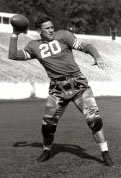
Eric Tipton
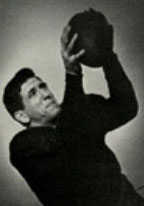
Bob Peoples
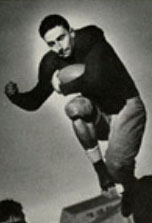
Mickey Anderson
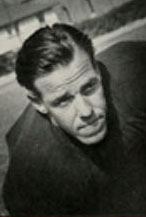
Ollie Day
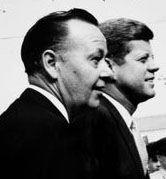
USC President Norman Topping with John F. Kennedy
|
|
|
What offensive adjustments did the wily Wade make at halftime to prepare his boys to receive the second half kickoff?
- Apparently not many because Duke punted on the first play!
- Finally, the Blue Devils got the break they'd been waiting for on Hill's midfield interception late in the third quarter. Tipton then fired a high, arching pass to George McAfee to put the ball on Troy's 24. Roger Robertson and Tipton punched their way to the 16. On fourth-and-two, third-string G Tony Ruffa booted a field goalfrom the 24 on the second play of the last period.
- Since their Devils had not surrendered a point all season, the Duke contingent waved their silk panties and let loose the Rebel yell in anticipation of victory.
- Countless Duke fans gathered around radios back in North Carolina shared the euphoria.
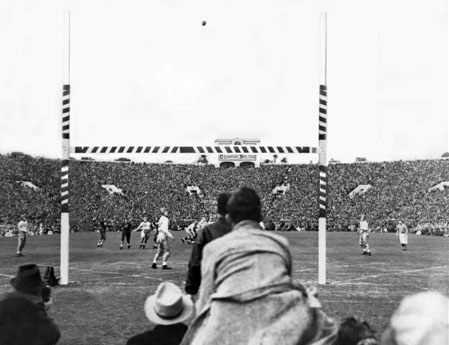 Duke
Duke takes the lead on Ruffa's field goal. USC couldn't get deep into enemy territory until Duke finally made a mistake midway through the quarter.
- Senior Bob Spangler unwisely tried to handle a punt on his own five only to have the ball get away into the hands of USC on the 10. Bob's teammates gathered around him and told him not to worry. They'd bail him out.
- And that's exactly what they did. On first down, Lansdell lost lost, then threw an incompletion. Granny ran the ball back to the 10 before USC incurred a 5y penalty for calling too many timeouts.
- Facing 4th down on the 23, Jones sent in kicker Phil Gasper to try a game-tying field goal that barely missed to the right. Duke fans waved their panties and roared even louder, convinced their heroes had withstood USC's last gasp.
Given a chance to at least run some clock, Wade's charges reverted to their usual strategy.
- After gaining little on first down, Tipton punted! The Trojans drove briefly before having to punt.
- Given still another opportunity to control the ball, Eric the Red booted on second down again! (Remember, with limited substitution, coaches didn't send in plays.)
Granny fair-caught the kick on the USC 39 to set up what might be the Trojans' last possession.
- With Duke in what today would be called a "prevent defense," Lansdell cut over right tackle for 5y. Then FB Bob Peoples circled left end, cut back, and ran into Perdue for only a 1y gain. Granny tried the same side to the Duke 48 for a first down. The tiring defense called a timeout to regroup to preserve their unsullied record for four more minutes.
- Continuing to run to the left, Lansdell moved to the 43. Then "Antelope Al" Krueger took the ball on an end around for only 2y. On third and third, Lansdell threw a ball clear across the field toward Peoples, who leaped and grabbed it between Spangler and Tipton for a first down on the 34.
With only two minutes left, USC had to pick up the pace. So Coach Jones made a fateful change at tailback.
Continued below ...
|

Tony Ruffa

Bob Spangler
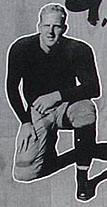
Phil Gasper
|
January 2, 1939: Duke vs Southern California
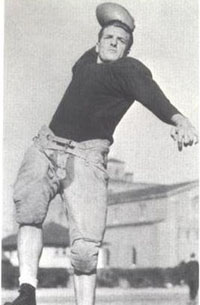
Doyle Nave

Howard Jones
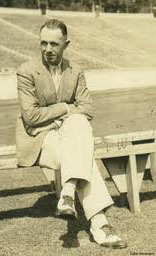
Wallace Wade
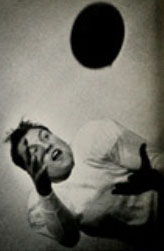
Al Krueger
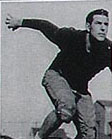
Bill Fisk
|
Doyle Nave hadn't seen much action for USC in 1938.
- As fourth-string tailback, the junior from Los Angeles had played only 35 minutes in the Trojans' ten regular season contests.
- Even if he had played the entire 60 minutes in the Rose Bowl game, he wouldn't have amassed the 175 minutes required to earn a letter.
- With two minutes remaining, he had yet to step on the playing field that day.
As USC, trailing Duke 3-0, took possession for its last thrust, Coach Howard Jones told his best passer to begin warming up.
- Jones had this dialog with the youngster:
Doyle, I'm thinking of putting you in.
What have you got in mind, coach?
The 27 series. Get the ball to Krueger. He's the best end we have for getting open.
- Nave recalled: Jones gave me a few minutes to warm up, and I was nervous. I'll tell you.
Finally, with two minutes remaining and the Trojans with 1st-and-10 on the Duke 34, Jones sent his best passer into the game. Or did he?
- In his 1989 book, The Tournament of Roses, Joe Hendrickson wrote this story about Joe Wilensky, the former Trojan lineman on Jones' coaching staff.
Wilensky was manning the telephone on the bench, relaying the messages of assistant coaches Sam Barry, Bob McNeish, and Julie Bescos, who had been observing the action high above in the press box. Suddenly Wilensky got an idea. He decided to take a chance to do something to pull out the victory. He knew the coaches above had already left the press box and were on their way to join the team. Nobody had scored a point all season against the great Duke line.
"Our only chance is to get Nave in there to pass," thought Wilensky. "He has the arm to hit [Al] Krueger and dent this great Duke defense." Wilensky snatched the phone. "Yes," he shouted so everybody on the bench could hear. "Yes, yes - I get it. I'll tell him right away." Wilensky slammed the receiver on the hook and excitedly nudged assistant coach Bill Hunter.
"The word is to send in Nave and have him throw to Krueger," said Wilensky to Hunter, who in turn passed it on to Jones. Nick Pappas, who helped Jones with the coaching ... verifies that this is the true story of how Nave got into the game.
- At any rate, Nave rushed into the game, and Jones didn't stop him. Doyle wore a bandage over a cut on his forehead that he had sustained in a scrimmage.
- On the opposite sideline, Coach Wallace Wade had no scouting report on Nave. The man Wallace assigned to scout the Trojans said later that, if they had known the bench-warmer had the best arm on the team, they would have rushed him hard.
Nave wasted no time putting the pigskin in the air.
- With Duke playing a prevent defense that involved rushing only one man, Krueger told Doyle: Just fade back with the ball and throw it to me when I give you the sign by waving my arms, no matter where I go.
- Krueger split time at left end with Bill Fisk. Al played the second and fourth quarters, as he explained years later. They put Fisk and the heavy team in first to wear the opposition down, and then let the light ones score the touchdowns.
- Al also recalled that he didn't second-guess the decision to remove Lansdell for Nave. "I just wanted to win the game. That was the only thing on my mind."
- With Duke rushing only one man and dropping ten back, Nave began with a button hook pass to Krueger for 12y. Doyle felt most comfortable with Krueger because they were both subs. Let Nave describe the next play. The second pass was a "27" with a flair, and Al went down and did a pivot and broke to the outside. He caught that and gave us a first down.
Clifton Herd, a USC scout, recalled: I felt sure that neither Wallace Wade nor his players knew very much about Nave. If they had suspected his passing ability, they would have rushed him more than they did. It looked to me as if Wade merely spread his defense, figuring that there wouldn't be time for the Trojans to score by running the ball. He wanted to be sure to pick up the receiver somewhere.
- With the ball on the left hash mark, Nave called a play to get the ball into the middle of the field to give Al more room to maneuver on the left side. It was a "27 end-around." Krueger came behind the line of scrimmage and caught my third straight pass, but a Duke lineman picked him up and we lost a few yards.
- With under a minute on the clock, Nave sent Antelope Al on a down and out into the end zone. To shake Tipton, the receiver suddenly stopped, then raced to the corner of the end zone while Doyle dropped deep to his right and hurled the ball as hard as he could diagonally across the field to the back of the end zone. Wide open and waving his arms, Krueger grabbed it with 40 seconds left to score the first points against Duke all season and send the USC partisans into a frenzy. Nave recalled: I was watching Al as he broke away from Eric Tipton. I threw the ball when he was on the 7 or 8y line heading for the left corner of the end zone. He had good hands, and I was praying that he could catch it - nothing's a sure thing in football. He made a terrific catch in the chest, and we just went berserk.

Al Krueger catches the TD pass as Eric Tipton looks on helplessly. Seated in his usual spot on the bench, Wade couldn't see the winning touchdown since his players were bunched together on the sideline, blocking his view.
Did he catch it? asked the usually calm coach anxiously. Yes, coach, said George McAfee. He caught it.
The winning play duplicated the one the Trojans had used to score in the last seconds of the first half to break the scoreless tie against Notre Dame except that Ollie Day had thrown that one to Krueger.
- Jones removed both of his heroes to put in defensive replacements. The Blue Devils tried to score, but the game ended when Tipton connected with McAfee who broke loose for 17y before the last Trojan caught him at the USC 40.
- The USC students tore the goal posts down at both ends of the field. Players and spectators hoisted Nave onto their shoulders and carried him off the field.
- Southern Cal had won its fifth Rose Bowl without a loss.
In the hospital where future USC President Norman Topping listened to the game, "something remarkable happened" when Nave threw the winning pass, as Norm recalled later. A miracle. It [the victory] did more for me than any medicine. My temperature immediately started going down. I recovered. I also won $50 on the game.
Topping recovered and, working for the National Institutes of Health a decade later, developed the first effective treatment for the Rocky Mountain fever that had nearly cost him his life.
|
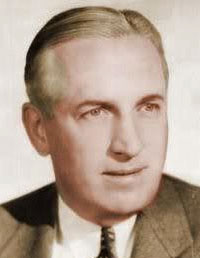
Braven Dyer
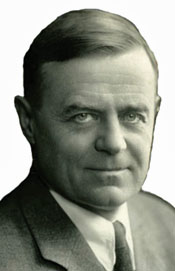
Bob Zuppke
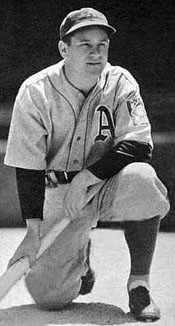
Eric Tipton
|
Writers flocked to the USC dressing room.
- Nave approached Coach Jones. Thanks for the chance, coach.
No, Doyle, it is I who thank you. I hope that what you just did out there will make up for the rest of the season. I tell you, this was worth waiting for.
It surely was, replied the blushing hero.
- Jones gave no hint of Wilensky's story. Instead, he said: Granny Lansdell was going great in those last few minutes, and I think that had there been more time he might have scored. But our only chance was to pass, and Nave is the best passer I have on the squad. I knew that Nave was the only man we had who might win the game for us at that time, and so I sent him out there and told him to get at least one of them off to Krueger.
- When asked if Nave would receive a letter despite not playing the necessary number of minutes in the season, Jones agreed to waive the rule. He's played enough to win anything he wants from me. Sure, it includes a letter. (Actually, the Athletic Board had to approve the recommendation, which it did.)
The victory especially pleased sports writer Braven Dyer of the Los Angeles Times. As part of his crusade to get USC to pass more, he had written an open letter to Jones in one of his columns asking the coach to "give my boy Doyle Nave a chance."
Unfortunately, Dyer missed his protege's crowning moment because he left early to beat the traffic and return to the Times' office to make his deadline. So he heard the final minutes on the radio along with several colleagues. There is no truth in the dastardly report that I promptly fainted at the wheel. The three gentlemen with me will testify that I kept right on driving into town just as if nothing had happened. The hell I did - I let out a yell which all but shattered the windshield and promptly began jabbering like an idiot. The "gridirony" of it all practically slays me.
Dyer eventually saw the movie of the game and appreciated Krueger's catching as much as Nave's throwing.
Duke coach Wallace Wade was not a happy camper after the game.
- We were all right as long as they didn't show us more than three teams. But when they came up with fresh and talented fourth-stringers, it was too much.
- But Wade wouldn't admit that USC was the best opponent his team had faced that season. He ranked Pittsburgh as the strongest team in the country, with Tennessee [whom Duke had not played] right behind them.
- The Duke coach also made a puzzling remark that reporters interpreted as sour grapes. This is a helluva place to bring a football team.
- Wade's attitude led some writers to claim that TCU should have been invited.
Wade went to the USC locker room after the game to congratulate Coach Jones. After doing so, Wade was leaving when a reporter asked if he would shake Doyle Nave's hand. The dejected coach replied, I've had enough of him for one day.
The West Coast writers seized on Wade's statement as evidence of poor sportsmanship. As a war of words broke out between the two coasts, Wade claimed that his practices had been spied on and vowed never to bring another team to the Rose Bowl.
When Nave was asked about being shunned, he pointed out that the Duke coach was not only preoccupied with the heartbreaking defeat but was also worried about his wife, who was ill back home in North Carolina.
Illinois's long-time coach Bob Zuppke attended the game and expressed the opinion that the better team had won.
- Southern California was the aggressive team. It carried the fight, it took all the chances. The Trojans made the show, and they deserved a victory over Duke, which was strictly a counter puncher.
- However, Zuppke didn't think much of the football played in the Rose Bowl game and thought that Michigan might have beaten either team without much trouble.
With the Rose Bowl game broadcast across the country, the Legend of Doyle Nave took all sorts of turns.
- Supposedly more than 250 Southern girls sent him proposals of marriage, and he received "crush letters" from ladies in such places as Omaha NE, Ellensburg WA, and Fairbanks PA.
- The mayor of Gordo AL sent Nave a message appointing him acting mayor of that town for January 16, 1939.
- A bedridden boy in Forestville CO
with infantile paralysis asked for an autograph.
- The National Association of the Deaf asked for confirmation of a report that Nave was hard of hearing. (He wasn't.)
Postscript #1: The Duke yearbook for 1939-40 didn't include a single word or picture about the Rose Bowl.
Postscript #2: World War II brought Nave together with Duke co-captain Dan Hill on an aircraft carrier in the Pacific.
Nave asked Hill:
When I came into the game, did you have any idea that I was going to pass?
Hill replied: Hell, no. We didn't even know who you were.
Nave also exchanged pleasant letters with Coach Wade during the war and visited the man whose dream season he had spoiled. (Wade served in the military from 1942-45.)
Postscript #3: Duke's star B Eric Tipton signed a baseball contract after playing for the Blue Devil diamond team in the spring of 1939. He played with the Philadelphia Athletics from 1939-41 (only three games in 1940 and 1941) and the Cincinnati Reds from 1942-45. He didn't serve in the military and never played pro football.
Returning to January 1939: Little did USC know that they would make the Rose Bowl again after the 1939 season and meet still another undefeated, untied, and unscored on southern team - Tennessee. References: The Trojans: A Story of Southern California Football, Ken Rappoport (1974)
Tournament of Roses: The First 100 Years, Joe Hendrickson (1989)
The USC Trojans: College Football's All-Time Greatest Dynasty, Steven Travers (2006)
Fields of Battle: Pearl Harbor, the Rose Bowl, and the Boys Who Went to War, Brian Curtis (2016)
Top of Page |
|
CONTENTS
1939 Rose Bowl - I
1939 Rose Bowl - II
1939 Rose Bowl - III
Memorable Games - VI
Memorable
Football Games Index
Football
Magazine
Golden Rankings Home |



















